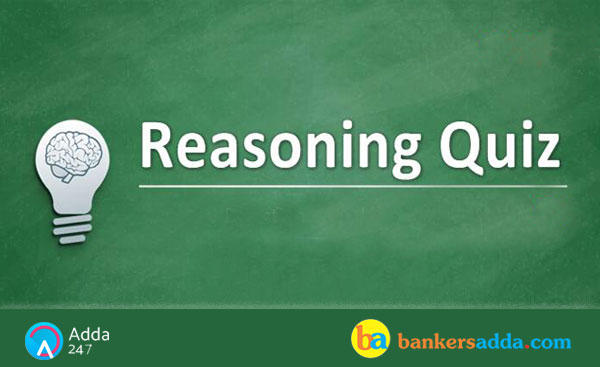Dear Aspirants,
Reasoning Ability is an onerous section. With the increasing complexity of questions, it becomes hard for one to give it the cold shoulder. The only way to make the grade in this particular section in the forthcoming banking exams is to practice continuously with all your heart and soul. And, to let you practice with the best of the latest pattern questions, here is the Adda247 Reasoning Quiz based on the exact same pattern of questions that are being asked in the exams.
Directions (1-5): Study the information and answer the given questions:
Seven persons P, Q, R, S, T, U and V live different floors of the same building having seven floors. Ground floor is numbered 1, first floor is numbered 2 and so on until the topmost floor is numbered 7. Each one of them was born in a different month of the same year starting from January to July but not necessarily the same order. V is not the oldest. Only one person lives between P and the youngest person. The second youngest person lives on an even numbered floor. Q neither lives immediately above nor lives immediately below the floor on which the third youngest person lives. Only three persons live between the persons who were born in July and April. R lives on the floor which is immediately below the floor on which T lives. Only two persons live between Q and the third oldest person. Only three persons live above the floor on which P lives. The person who was born in March lives on one of the floors below the floor on which Q lives. P does not live immediately above or immediately below S. The person who was born in the month of June lives on the floor which is immediately above the floor on which U lives. The person who lives immediately above V was not born in July.
Q1. How many persons living above V are older than V?
(a) One
(b) Two
(c) Three
(d) Four
(e) None of these
Q2. Who among the following lives on the third floor?
(a) The oldest person
(b) U
(c) R
(d) V
(e) T
Q3. Who lives on the floor which is immediately above the floor on which T lives?
(a) P
(b) Q
(c) S
(d) V
(e) U
Q4. How many persons living below S are younger than S?
(a) None
(b) Two
(c) One
(d) More than three
(e) Three
Q5. How many persons live between the floors on which the youngest and the oldest person lives?
(a) None
(b) Two
(c) One
(d) More than three
(e) Three
Directions (6-10): In the following questions the symbols $, #, @, % and are used with the following meanings illustrated as below:
‘A $ B’ means ‘A is not smaller than B’.
‘A # B’ means ‘A is neither greater than nor equal to B’.
‘A @ B’ means ‘A is neither smaller than nor equal to B’.
‘A % B’ means ‘A is not greater than B’.
‘A «B’ means ‘A is neither greater than nor smaller than B’.
In each of the following questions assuming the given statements to be true, find out which of the three conclusions I, II and III given below them is/are definitely true and indicate your answer accordingly.
Q6. Statements:
W « J, J @ O, O $ Y, Y # T
Conclusions:
I. W @ Y
II. Y « W
III. T @ O
(a) Either I or II only
(b) I and II only
(c) I only
(d) II and III only
(e) None is true
Q7. Statements:
A @ B, B # P, P % N, N @ G
Conclusions:
I. A @ N
II. B @ G
III. A # P
(a) I only
(b) II and III only
(c) Either I or III only
(d) All I, II and III
(e) None of true
Q8. Statements:
K # N, N % I, I « G, G# O
Conclusions:
I. K # I
II. K « I
III. N % O
(a) I only
(b) Either I or II only
(c) III only
(d) All I, II and III
(e) None is true
Q9. Statements:
U @ S, N % S, N $ I, T « N
Conclusions:
I. U $ I
II. U @ I
III. S $ T
(a) II and III only
(b) II only
(c) III only
(d) III and either I or II
(e) None is true
Q10. Statements:
P @ G, G # W, W « U, U % T
Conclusions:
I. T @ P
II. T « G
III. T @ G
(a) I and II only
(b) II and III only
(c) Either II or III only
(d) III only
(e) None is true
Directions (11-13): Question consists of five statements followed by five conclusions. Consider the given statements to be true even if they seem to be at variance with commonly known facts. Read all the conclusions and then decide which of the given conclusions does not logically follow from the given statements using all statements together.
Q11. Statements: Some sponge is dust. All dust is rust. No rust is square. All rod is square. Some rod is cap.
Conclusions:
(a) Some sponge is rust.
(b) Some sponge is not square.
(c) No dust is square.
(d) Some cap is square.
(e) All follows
Q12. Statements: All doll is man. Some doll is march. All march is knife. No march is gun. Some gun is pin.
Conclusions:
(a) Some doll is knife.
(b) Some march is man.
(c) Some knife is not gun.
(d) Some pin is knife.
(e) All follows
Q13. Statements: Some chain is lava. Some lava is iron. Some iron is sword. Some sword is rod. Some rod is fish.
Conclusions:
(a) Some lava is chain.
(b) Some fish is rod.
(c) Some sword is lava.
(d) Some rod is sword.
(e) All follows
Directions (14-15): In the questions below are given some conclusions followed by five set of statements. You have to choose the correct set of statements that logically satisfies given conclusions. Assume the given statements to be true even if they seem to be at variance from commonly known facts.
Q14. Conclusions: Some leg is heart. Some toe is not heart.
Statements:
(a) Some toe is silk. No silk is heart. Some heart is fair. All fair is leg. No leg is violet.
(b) Some toe is heart. All heart is silk. No silk is fair. Some fair is leg. All leg is violet.
(c) Some fair is leg. All leg is violet. No violet is toe. Some toe is heart. All heart is silk.
(d) Some fair is violet. All violet is leg. No leg is toe. All toe is heart. Some toe is silk.
(e) None of these.
Q15. Conclusions: Some fungus is weed. Some weed is milk.
Statements:
(a) Some milk is weed. All weed is bean. Some bean is tree. All tree is fungus. Some tree is nose.
(b) Some milk is tree. All tree is fungus. Some fungus is nose. All nose is bean. Some bean is weed.
(c) Some milk is nose. All nose is bean. Some bean is weed. All weed is tree. Some tree is fungus.
(d) All milk is bean. Some milk is weed. Some weed is tree. All tree is fungus. Some fungus is nose.
(e) None of these.





 The Hindu Review October 2022: Download ...
The Hindu Review October 2022: Download ...
 SBI SO Salary 2024, Salary Structure, Pe...
SBI SO Salary 2024, Salary Structure, Pe...
 SBI Clerk Previous Year Question Paper P...
SBI Clerk Previous Year Question Paper P...



